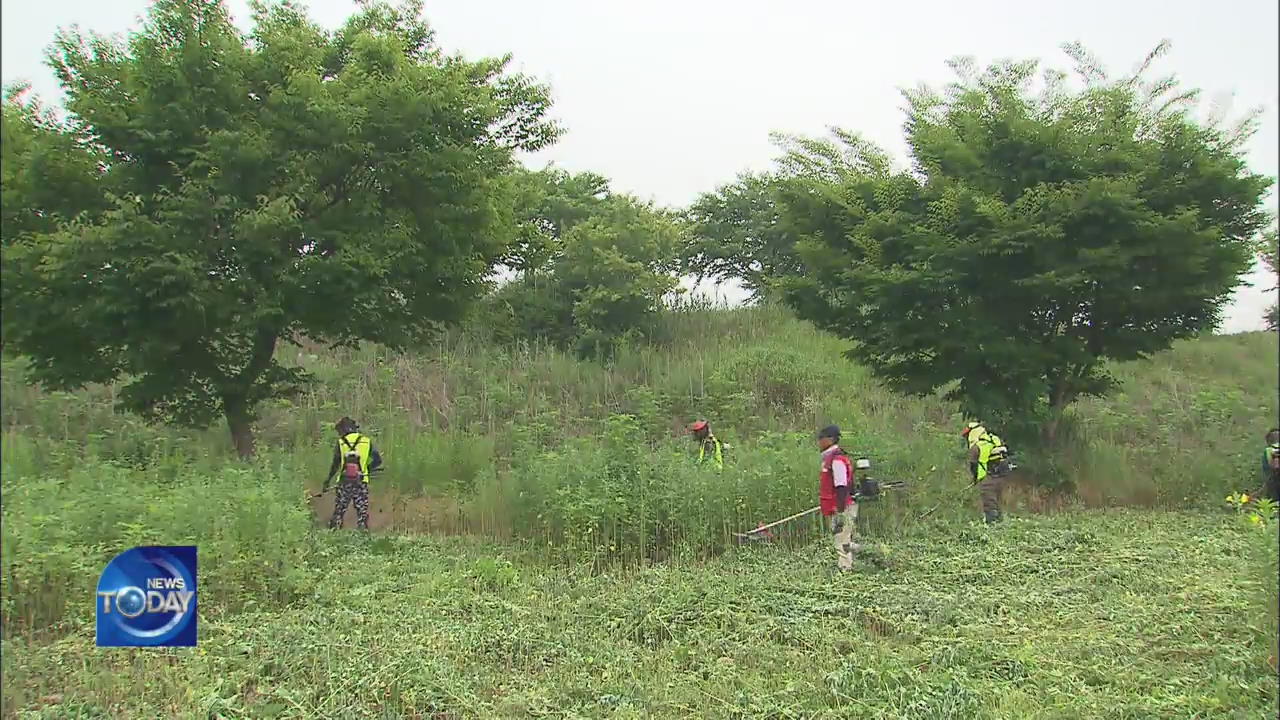RISK TO UNESCO BIOSPHERE RESERVE
입력 2019.07.30 (15:03)
수정 2019.07.30 (16:45)
읽어주기 기능은 크롬기반의
브라우저에서만 사용하실 수 있습니다.
[Anchor Lead]
The Imjin-gang River area in Yeoncheon, Gyeonggi-do Province is known for its scenic beauty and rich ecosystem. This was recognized, and the area was registered as a UNESCO biosphere reserve last month. But in recent years, excessive growth of foreign plant species has been a threat to the region. Take a look.
[Pkg]
Plants, standing taller than most adults grow along the riverside. These are giant ragweeds originating from North America. They are spreading fast and driving out native plants such as the evening primrose. In August, their pollen is scattered about, causing various allergic diseases. The ragweeds need to be chopped down before they bloom but as they've spread so far and wide, it's hard to get the job done quickly.
[Soundbite] KIM YEONG-MAN(YEONCHEON WILDLIFE MANAGEMENT ASSOCIATION) : "The plants are so large we need to chop them down 2 to 3 times. It's a demanding process."
However, their numbers are decreasing thanks to annual removal efforts.
[Soundbite] KIM GYEONG-DO(HANTAN-GANG RIVER PRESERVATION CAMPAIGN) : "Four years of removal work has reduced their numbers by 70%. We believe just cutting them down is the best way."
But it's not only the giant ragweeds. Many other foreign plant species thrive in the Imjin-gang River area, disrupting the indigenous ecosystem.
[Soundbite] CHAE TAEK-BYEONG(YEONCHEON-GUN COUNTY) : "We will continue removal operations and budget allocations on a five-year basis to restore Imjin-gang River to its original state."
Experts say the current method of renovating streams also needs to be changed because reckless construction destroys the habitat of native plants such as reed and silver grass.
The Imjin-gang River area in Yeoncheon, Gyeonggi-do Province is known for its scenic beauty and rich ecosystem. This was recognized, and the area was registered as a UNESCO biosphere reserve last month. But in recent years, excessive growth of foreign plant species has been a threat to the region. Take a look.
[Pkg]
Plants, standing taller than most adults grow along the riverside. These are giant ragweeds originating from North America. They are spreading fast and driving out native plants such as the evening primrose. In August, their pollen is scattered about, causing various allergic diseases. The ragweeds need to be chopped down before they bloom but as they've spread so far and wide, it's hard to get the job done quickly.
[Soundbite] KIM YEONG-MAN(YEONCHEON WILDLIFE MANAGEMENT ASSOCIATION) : "The plants are so large we need to chop them down 2 to 3 times. It's a demanding process."
However, their numbers are decreasing thanks to annual removal efforts.
[Soundbite] KIM GYEONG-DO(HANTAN-GANG RIVER PRESERVATION CAMPAIGN) : "Four years of removal work has reduced their numbers by 70%. We believe just cutting them down is the best way."
But it's not only the giant ragweeds. Many other foreign plant species thrive in the Imjin-gang River area, disrupting the indigenous ecosystem.
[Soundbite] CHAE TAEK-BYEONG(YEONCHEON-GUN COUNTY) : "We will continue removal operations and budget allocations on a five-year basis to restore Imjin-gang River to its original state."
Experts say the current method of renovating streams also needs to be changed because reckless construction destroys the habitat of native plants such as reed and silver grass.
■ 제보하기
▷ 카카오톡 : 'KBS제보' 검색, 채널 추가
▷ 전화 : 02-781-1234, 4444
▷ 이메일 : kbs1234@kbs.co.kr
▷ 유튜브, 네이버, 카카오에서도 KBS뉴스를 구독해주세요!
- RISK TO UNESCO BIOSPHERE RESERVE
-
- 입력 2019-07-30 14:56:07
- 수정2019-07-30 16:45:31

[Anchor Lead]
The Imjin-gang River area in Yeoncheon, Gyeonggi-do Province is known for its scenic beauty and rich ecosystem. This was recognized, and the area was registered as a UNESCO biosphere reserve last month. But in recent years, excessive growth of foreign plant species has been a threat to the region. Take a look.
[Pkg]
Plants, standing taller than most adults grow along the riverside. These are giant ragweeds originating from North America. They are spreading fast and driving out native plants such as the evening primrose. In August, their pollen is scattered about, causing various allergic diseases. The ragweeds need to be chopped down before they bloom but as they've spread so far and wide, it's hard to get the job done quickly.
[Soundbite] KIM YEONG-MAN(YEONCHEON WILDLIFE MANAGEMENT ASSOCIATION) : "The plants are so large we need to chop them down 2 to 3 times. It's a demanding process."
However, their numbers are decreasing thanks to annual removal efforts.
[Soundbite] KIM GYEONG-DO(HANTAN-GANG RIVER PRESERVATION CAMPAIGN) : "Four years of removal work has reduced their numbers by 70%. We believe just cutting them down is the best way."
But it's not only the giant ragweeds. Many other foreign plant species thrive in the Imjin-gang River area, disrupting the indigenous ecosystem.
[Soundbite] CHAE TAEK-BYEONG(YEONCHEON-GUN COUNTY) : "We will continue removal operations and budget allocations on a five-year basis to restore Imjin-gang River to its original state."
Experts say the current method of renovating streams also needs to be changed because reckless construction destroys the habitat of native plants such as reed and silver grass.
The Imjin-gang River area in Yeoncheon, Gyeonggi-do Province is known for its scenic beauty and rich ecosystem. This was recognized, and the area was registered as a UNESCO biosphere reserve last month. But in recent years, excessive growth of foreign plant species has been a threat to the region. Take a look.
[Pkg]
Plants, standing taller than most adults grow along the riverside. These are giant ragweeds originating from North America. They are spreading fast and driving out native plants such as the evening primrose. In August, their pollen is scattered about, causing various allergic diseases. The ragweeds need to be chopped down before they bloom but as they've spread so far and wide, it's hard to get the job done quickly.
[Soundbite] KIM YEONG-MAN(YEONCHEON WILDLIFE MANAGEMENT ASSOCIATION) : "The plants are so large we need to chop them down 2 to 3 times. It's a demanding process."
However, their numbers are decreasing thanks to annual removal efforts.
[Soundbite] KIM GYEONG-DO(HANTAN-GANG RIVER PRESERVATION CAMPAIGN) : "Four years of removal work has reduced their numbers by 70%. We believe just cutting them down is the best way."
But it's not only the giant ragweeds. Many other foreign plant species thrive in the Imjin-gang River area, disrupting the indigenous ecosystem.
[Soundbite] CHAE TAEK-BYEONG(YEONCHEON-GUN COUNTY) : "We will continue removal operations and budget allocations on a five-year basis to restore Imjin-gang River to its original state."
Experts say the current method of renovating streams also needs to be changed because reckless construction destroys the habitat of native plants such as reed and silver grass.
이 기사가 좋으셨다면
-
좋아요
0
-
응원해요
0
-
후속 원해요
0













![[단독] 도이치 주포 “김건희, 내 덕에 떼돈 벌어…22억 원 주문”](/data/news/2025/07/03/20250703_KpuU43.png)
![[단독] “쪽지 얼핏 봤다, 안 받았다”더니…CCTV에선 문건 챙긴 이상민](/data/news/2025/07/03/20250703_Lv3LjI.png)


이 기사에 대한 의견을 남겨주세요.